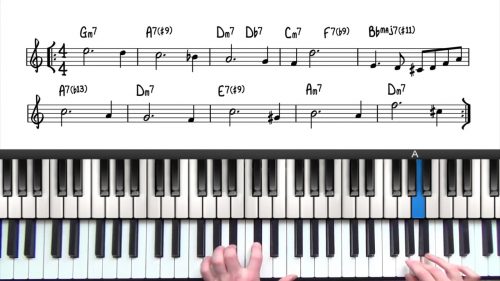Bossa Nova Bass Line Rhythm & Groove
Welcome to part 2 of this course on the music of Brazil. In this lesson, we will break down the rhythms of Bossa Nova and Samba music.
We will examine the components of both the right and left-hand and explore the interplay between the drums, the bass lines, and the harmony. The left-hand takes the role of the Surdo drum, and the right-hand takes the role of the Tamborim.
Bass Patterns & Bass lines in Samba & Bossa Nova
The bass patterns in Bossa Nova and Samba are driven by the left hand. Samba can be defined as a 2 layer rhythm where 1 rhythm is non-syncopated. The bass line pattern is the non-syncopated element and this is performed by the Surdo drum in the Samba band.
The Accent On The 2nd Beat
If you are used to playing a lot of European inspired music, you might find it unusual to place the emphasis on the 2nd beat. Using western classical music as an example, you will notice that the accents are always on the downbeat.
In Brazilian music, the accent is placed on the 2nd beat.
The Syncopated Element
The second layer of the Samba is a syncopated line which takes the role of the Tamborim drum. You must have the non-syncopated line of the Surdo in order to achieve the combination of these rhythms. This left-hand bass line gives the right-hand line a reference from which to be syncopated.
Bass Line Ghost Notes
The ghost notes in the bass line are a very important element of the Samba & Bossa Nova Grooves. In the lesson, we will explore and demonstrate the correct way to play ghost notes, and the incorrect “16th note approach” which is a common slipping point that will ruin the sense of groove.
Anticipating & Delaying The Harmony
Anticipation is another key ingredient of the groove. When the harmony is being syncopated, we must ensure that the chords do not always fall on the downbeats. This gives you the choice of playing the chords either before, or after the beat.
In this style of music, anticipating the chord is more common but both can be effective. Study the examples in this lesson to get the right ‘feel’ and sense of groove when playing this music.
Lesson Downloads
-
Basslines & Comping Patterns File Type: pdf
Practice Tips
-
Practice the clapping rhythms outlined in this lesson whilst tapping your foot to the down beat.
-
This will help you understand and 'feel' the syncopated right-hand chords against the non-syncopated left-hand bass line.
-
Once this has been absorbed, then translate the rhythms to the piano.
-
Start by playing a 2 bar vamp over a single chord type. In the lesson, we demonstrate a 2 bar vamp in D Minor.
-
Experiment with the different placement of the right-hand comping chords by playing them on the beat, off the beat, and fully syncopated as demonstrated in the lesson.
-
Next move onto a 2 bar vamp. We will demonstrate using the chords G-7 and C7.
-
Pay attention to the anticipation of the chords.
-
Also, notice the nuances of the demonstrations such as ghost notes and accents on different beats of the bar.







great lesson ! at last a clear explanation of bossa rhythms
just two considerations
–> why there is not the possibility to slow down the time here ( and seems to me also in subsequent lessons) , as in lesson 1 ? it should be very useful
–> the downloadable sheet could be richer, i’ve count at least 10 variations of basic II – V patter
many thanks
Hi Alessandro 👋
I have added the speed controls – you should now see them.
There is a PDF in the “Downloads” section which contains the lesson notation.
Cheers!
Hayden
Totally mindblown .. I just love these grooves! Thank you so much for the excellent lesson! the speed control works amazing! Yay 🙂
Hi Jovino,
I’m working on my basic groove and I was wondering if you can take a quick look at this video below and tell me if I’m on the right track.
https://drive.google.com/file/d/1BuvEXoYeJIHshVl4iN4pHB5tPQ-NLvWC/view?usp=sharing
Thanks. ~Eugene
Jonivo,
I know you’ve covered a number of tunes in this course, but I was wondering if you’ve thought about covering the song “Black Orpheus” in A minor. The song goes by a few different names, one being ‘Manha De Carnaval”. I believe that Antonio Carlos Jobim contributed to this song, I’m not sure how much of the writing was his, and maybe I’m way off base on that. But the song instantly evokes a sunny Brazilian beach.
thanks, Michael
Hello Michael, Thanks for your comment. We will definitely consider doing a seminar on “Manhã de Carnaval”, as it is a favorite tune for so many people. Regarding the composition, this tune is by Luiz Bonfá, a great guitarist and composer. Jobim composed other tunes for the original play that originated the films, but not this one. The original lyrics were by Antonio Maria, and it was sung by Agostinho dos Santos on the first BW film. Thanks again, best wishes! Jovino
Ola Jovino, Would you be so kind as to help me by commenting on the rhythms of Jobim’s Amparo for me? I LOVE this piece! You know how strict classical music 2 against 3 is alway followed, but I am wondering if this piece must be played in a strict rhythm? Thank you so much for your help and also you fantastic course. Working on these pieces gives me such pleasure!
I so appreciate your time. Ciao, N